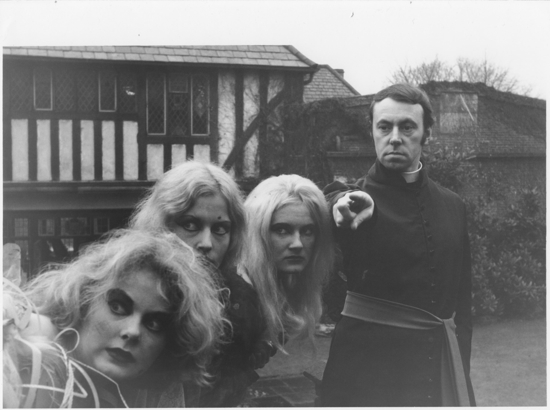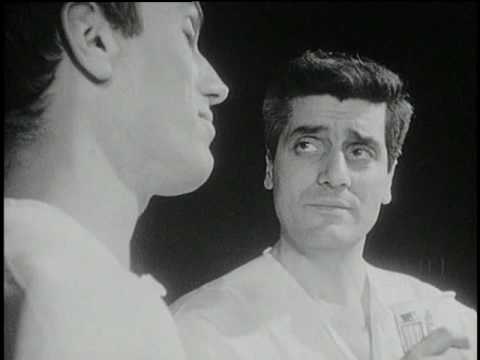"When you watch an Andy Milligan movie you’re in no doubt whose film you’re watching," writes Nicolas Winding Refn in the sleeve notes for the first-ever home entertainment presentation of 1970’s Nightbirds, a lovingly realised BFI Flipside project which the man behind Drive and the Pusher trilogy instigated. "He was sort of a Douglas Sirk figure."
Superficially, it may seem odd to compare the king of opulent, Golden Age melodrama to a marginal journeyman whose filmography includes such titles as Torture Dungeon (1969), Guru, The Mad Monk (1970), Fleshpot On 42nd Street (1972), Blood (1973) and Carnage (1983). But as the Danish auteur states, subtext is instrumental to both. Sirk’s beautifully crafted box office hits come laced with a bitterly ironic critique of 1950s mores and gender inequality. Likewise, the sex and gore in Milligan’s cheap ‘n’ sordid confections are secondary to astringent characterisation and prolix ranting, deployed to convey their creator’s disdain for humanity.
Refn purchased the materials which helped to assemble this new DVD on eBay, from the personal collection of master biographer Jimmy McDonough, who served as a junior crew member on Milligan’s unreleased LA punk picture Monstrosity (1987). McDonough’s immense 2001 tome The Ghastly One: The Sex-Gore Netherworld Of Filmmaker Andy Milligan delineates his former boss’s sadistic perspective thusly: "Women are conniving, narcissistic creatures; men are either pathetically weak or sociopathic monsters… Nobody gets along in Andy’s movies; everybody’s on the make… Empathy is reserved for society’s freaks – hunchbacks, cripples, and other disadvantaged souls portrayed as innocents who’ve been fatally damaged by the world."
Born to dysfunction in St Paul, Minnesota, after cutting family ties Milligan enjoyed his burgeoning homosexuality in California thanks to the United States Navy, then travelled the nation as a nightclub puppeteer. New York soon beckoned. His brief television acting stint – apparently derailed by a vicious rumour spread by juvenile contemporary James Dean – gave way to a more successful trade in dressmaking (the subsequent, oft-seen movie credit ‘Costumes by Raffiné’ referred to Milligan’s boutique on Staten Island). This compulsive jack of all trades properly cut his teeth at Greenwich Village coffeehouse Caffe Cino, an outcasts’ petri dish which birthed the entire Off-Off-Broadway theatre movement. Milligan’s extreme events included a pair of notorious Jean Genet plays (Deathwatch, The Maids) that dominated the tiny venue with lurid lighting, simulated S&M and risqué wardrobe designs; Yeats’ Purgatory rendered with actual violence; plus a grape-juice-for-blood-bags take on Spanish provocateur Fernando Arrabal’s The Two Executioners, which culminated in offstage screams so convincing they drew the NYPD to nearly every performance.
Having failed with his own East Village venture the Showboat Theater (a converted leather bar), Milligan transitioned to celluloid in 1965 with Vapors, recently reissued on the BFI compilation Encounters: Four Ground-breaking Classics Of Gay Cinema. Set in a Lower East Side bathhouse, this black and white short depicts a sensitive meet curious between gay, inscrutable Thomas (played by the director’s flatmate Gerry Jacuzzo) and older married man Mr Jaffe (Caffe Cino veteran Bob Dahdah). Their conversation is frequently interrupted by a screeching pack of voyeuristic ultra-queens, who serve as a wayward, winningly potty-mouthed Greek chorus.
The budgetary constraints are clear: you can hear the whirring of Milligan’s 16mm Auricon camera, a portable device which recorded sound onto the same stock as the photographed image (it was better suited for gathering newsreel footage). Nevertheless, the principals’ strong, sombre presence and a necessarily claustrophobic mise-en-scène lend the 32 minutes a veracity which allowed Vapors to be billed as ‘A major homosexual film comparable to [Kenneth] Anger’s Fireworks‘, when it premiered at counterculture den The Bridge on St Mark’s Place. Crucially, although the piece had been scripted by actress Hope Stansbury, its director tacked on a final flourish of full-frontal nudity involving genial masochist/exhibitionist Gary Stone. His taboo-busting member required a black censorship strip and enabled Vapors to cross over from the experimental cognoscenti to Times Square’s lucrative sexploitation circuit, blown up to 35mm and trailed by fresh, grindhouse-friendly taglines: ‘The Year’s Most Controversial Underground Film’, ‘From The Tearoom To The Steamroom!’
Milligan flew into overdrive in the late ’60s, cranking out ten swinging shockers for the 42nd Street fleapits (plus an additional three that remained unfinished or unreleased), mostly under the aegis of sleaze mogul William Mishkin (whose promotional moxie could conjure salacious money-spinners from tame product). He soon came to the attention of Soho-based executive Leslie Elliot, who profitably distributed such efforts as The Filthy Five and Tricks Of The Trade (both 1968) through British sex cinemas. Before the decade was out, Elliot brought Milligan over to London for a prolific 18-month sojourn, during which the avowedly independent director made five features. The first was Nightbirds, which was shot in Spitalfields and, as DVD essayist Stephen Thrower observes, is "a downbeat psychodrama quite unlike any of his other surviving films".
Despite the poster’s adults only promise – ‘The Compelling Story Of Two Young "Alives" Facing A Moral Self-Destruction They Dare Not Admit!’ – this spartan, monochrome rarity secured but a solitary public screening at New York’s Cameo Theatre. Bequeathed to McDonough and later bought by Refn, its lone print was missing several key moments due to Milligan excising them for the piquant trailer below. The BFI Flipside team had to undertake considerable detective work to achieve its transfer, a technical process detailed by regular tQ scribe Anthony Nield in Anatomy Of A Flipside, a fascinating series of articles for The Digital Fix.
As with Vapors, it’s essentially another two-hander. Unlike that tender debut, the central relationship is straight… and twisted. Worldly, manipulative Dee (Julie Shaw) picks up homeless, virginal Dink (Berwick Kaler) while the latter is vomiting on the pavement. She moves him into her barely furnished Commercial Street flat, where a creepy landlord implies the method of paying rent. Milligan’s trusty Auricon pulls tight focus on the nascent couple as their initial attempts to play house curdle into a tragically imbalanced power dynamic. Dee’s layers of mendacity are steadily peeled back, the taut narrative assuming an inexorable downward spiral for Dink (cue one of the director’s signature ‘swirl camera’ climaxes).
Candid for the time, though decidedly unerotic, Nightbirds‘ wicked woman/hapless man paradigm is indelible childhood residue: Milligan simply despised his volatile, abusive mother. Hence the unabashed misogyny which consumes much of his output like a red-raw wound. For her part, Shaw inhabits the icy toxic blonde with real verve, though she understandably baulked at a scene of animal cruelty alluded to by the working title Pigeons (needless to say, Milligan executed this nasty business himself). Surprisingly, the actress appeared in little else of note. In happy contrast, budding talent Kaler went on to a decades-spanning career in TV and on the stage. For the past 35 years he’s starred as the dame in York Theatre Royal’s annual panto, actually writing the production since 1981, and has been awarded the freedom of the city.
Kaler’s flexibility earned him supporting roles in the rest of Milligan’s UK flicks, which ranged from brutal Sweeney Todd and Jekyll & Hyde adaptations (Bloodthirsty Butchers and The Man With Two Heads, respectively) to a rodent and lycanthrope saga that was merely rated PG (The Rats Are Coming! The Werewolves Are Here!, originally pitched as Curse Of The Full Moon). The actor elicits sympathy as a naive, hunchbacked underling in The Body Beneath (1970), presented as a restored extra on the Nightbirds disc. Briefly utilising the yet to be renovated decrepitude of Highgate Cemetery, this colourful slice of Swinging London gothic largely unfolds amid the neo-Tudor interiors of Sarum Chase (rechristened ‘Carfax Abbey’): a Grade II listed mansion overlooking Hampstead Heath, which also supplied the location for The Rolling Stones’ Beggars Banquet album photoshoot. The plot is given wings by a gloriously committed lead turn from Gavin Reed as incestuous vampire priest Reverend Alexander Algernon Ford, who kidnaps his female descendants for a ritual sacrifice. He’s accompanied by a spooky silent coven. Their myriad transgressions span arson against the person, knitting needle slaughter and a quasi-crucifixion.
Reed’s ripe sneer compensates for his director’s often jarring selection of jaunty library music (a financial limitation) and the occasional shoddily framed close-up (Milligan was always an impatient taskmaster). The Body Beneath is further elevated by a vividly hued, cannibalistic feast sequence, which grows unusually abstract and evocative. However, what happens next is more typical. Instead of building to a cacophonous orgy, the nefarious hedonism just devolves into a verbose debate about the relative merits of England versus the USA, contested by the evil clergyman and a fellow undead reveller. This inaction helps explain Milligan’s perennially low standing among the horror firmament; Stephen King famously dismissed 1968’s The Ghastly Ones as "the work of morons with cameras".
For all the catchy slogans advertising his ignoble enterprises, the writer-director didn’t provide enough pulp thrills to secure cult canonisation. Equally, he wasn’t Ed Wood. The Milligan aesthetic was stark, angry and unyielding – not approachably kitsch. Near the end of his life he relocated to Hollywood and slid from severity towards dismal camp: 1988’s comedic hospital swansong Surgikill is pure bathos. (Milligan died three years later, ravaged by AIDS.) But the oeuvre’s high points evince a seriousness that marks him out as a true believer in his chosen medium, intent on communicating a distinctive worldview, albeit one that encompassed depravity and hate. These stains on the wider cinematic conscience might be small, but they still linger.
A Dual Format Edition of Nightbirds is out now via BFI Flipside, with bonus material including The Body Beneath. Jimmy McDonough’s definitive book The Ghastly One: The Sex-Gore Netherworld Of Filmmaker Andy Milligan is currently out of print, but well worth tracking down.



